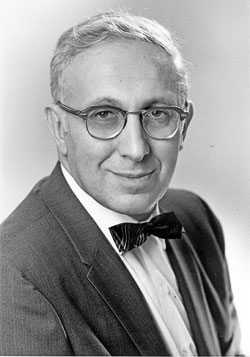Remembering Robert J. Myers
Social Security Bulletin, Vol. 70, No. 2, 2010 (released May 2010)

SSA History Archives.
Robert J. Myers died on February 13, 2010, at age 97. He devoted his life to Social Security and made an indelible mark on the program.
After receiving a Masters Degree in Actuarial Science from the University of Iowa in 1934, Robert Myers began his career as a junior actuary with the Committee on Economic Security—which he described as being a matter of great good luck—simply being in the right place at the right time. In this position, he helped shape the Social Security program that was enacted into legislation one year later in 1935. One of his tasks was to figure out a fundamental detail of the program—the age at which people should become eligible to stop working and start drawing benefits, while still allowing the program to pay for itself. The result was the age-65 retirement age.
Myers was among the early employees of the Social Security Board (the precursor to the Social Security Administration), becoming a permanent Social Security actuary in the summer of 1936. By 1947, he became the Chief Actuary of Social Security. He was the longest-serving Chief Actuary, serving for 23 years from 1947 to 1970. During this period, he played an instrumental role in several pieces of major legislation, including the expansion of coverage in 1950, enactment of disability insurance in 1956, and enactment of Medicare in 1965. Also, as Chief Actuary, he introduced the 75-year long-range projection of the actuarial balance of the trust fund. This projection was not widely used in other countries, but is a hallmark of our annual Trustees Reports.
To assist with efforts to deal with the financing crisis, Myers returned to the Social Security Administration in 1981 for about a year as the Deputy Commissioner for Programs. Long after leaving the Social Security Administration, he continued his involvement in the Social Security program. He served on numerous commissions and Congressional panels. Notably, in 1983, he was named the executive director of the National Commission on Social Security Reform (also known as the Greenspan Commission), which succeeded in developing a consensus recommendation that became the 1983 Amendments to the Social Security Act. He was a prolific writer, with more than 900 articles and several books to his name and held a record for having testified before Congress 175 times. Myers was also a leader in the broader fields of social insurance and actuarial science. He was a founding member of the National Academy of Social Insurance, serving on its Board of Directors from 1986–87. In 1994, the American Academy of Actuaries created the Robert J. Myers Public Service Award to honor actuaries who have made an exceptional contribution to the common good. He also served as the president of both the Society of Actuaries and the American Academy of Actuaries.
Myers' work, although esoteric, touched the lives of millions of Americans. Stephen Goss, the Chief Actuary at the Social Security Administration since 2001, says Myers was singularly responsible for the strength and principles now cherished and guarded at the office he formed." The former Senator Daniel Patrick Moynihan once described him as "a national treasure."